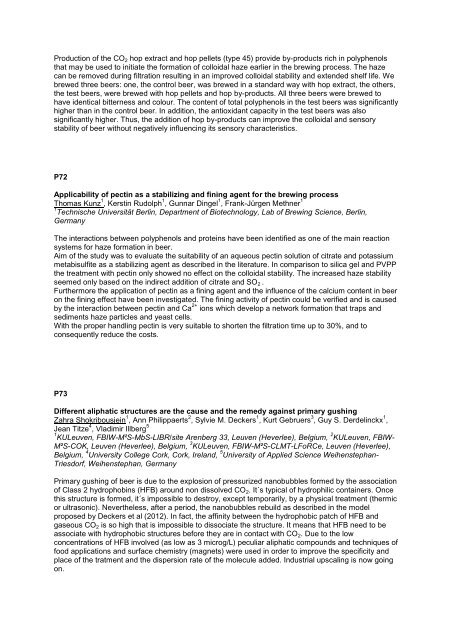here - the 34th European Brewery Convention
here - the 34th European Brewery Convention
here - the 34th European Brewery Convention
You also want an ePaper? Increase the reach of your titles
YUMPU automatically turns print PDFs into web optimized ePapers that Google loves.
Production of <strong>the</strong> CO 2 hop extract and hop pellets (type 45) provide by-products rich in polyphenols<br />
that may be used to initiate <strong>the</strong> formation of colloidal haze earlier in <strong>the</strong> brewing process. The haze<br />
can be removed during filtration resulting in an improved colloidal stability and extended shelf life. We<br />
brewed three beers: one, <strong>the</strong> control beer, was brewed in a standard way with hop extract, <strong>the</strong> o<strong>the</strong>rs,<br />
<strong>the</strong> test beers, were brewed with hop pellets and hop by-products. All three beers were brewed to<br />
have identical bitterness and colour. The content of total polyphenols in <strong>the</strong> test beers was significantly<br />
higher than in <strong>the</strong> control beer. In addition, <strong>the</strong> antioxidant capacity in <strong>the</strong> test beers was also<br />
significantly higher. Thus, <strong>the</strong> addition of hop by-products can improve <strong>the</strong> colloidal and sensory<br />
stability of beer without negatively influencing its sensory characteristics.<br />
P72<br />
Applicability of pectin as a stabilizing and fining agent for <strong>the</strong> brewing process<br />
Thomas Kunz 1 , Kerstin Rudolph 1 , Gunnar Dingel 1 , Frank-Jürgen Methner 1<br />
1 Technische Universität Berlin, Department of Biotechnology, Lab of Brewing Science, Berlin,<br />
Germany<br />
The interactions between polyphenols and proteins have been identified as one of <strong>the</strong> main reaction<br />
systems for haze formation in beer.<br />
Aim of <strong>the</strong> study was to evaluate <strong>the</strong> suitability of an aqueous pectin solution of citrate and potassium<br />
metabisulfite as a stabilizing agent as described in <strong>the</strong> literature. In comparison to silica gel and PVPP<br />
<strong>the</strong> treatment with pectin only showed no effect on <strong>the</strong> colloidal stability. The increased haze stability<br />
seemed only based on <strong>the</strong> indirect addition of citrate and SO 2 .<br />
Fur<strong>the</strong>rmore <strong>the</strong> application of pectin as a fining agent and <strong>the</strong> influence of <strong>the</strong> calcium content in beer<br />
on <strong>the</strong> fining effect have been investigated. The fining activity of pectin could be verified and is caused<br />
by <strong>the</strong> interaction between pectin and Ca 2+ ions which develop a network formation that traps and<br />
sediments haze particles and yeast cells.<br />
With <strong>the</strong> proper handling pectin is very suitable to shorten <strong>the</strong> filtration time up to 30%, and to<br />
consequently reduce <strong>the</strong> costs.<br />
P73<br />
Different aliphatic structures are <strong>the</strong> cause and <strong>the</strong> remedy against primary gushing<br />
Zahra Shokribousjein 1 , Ann Philippaerts 2 , Sylvie M. Deckers 1 , Kurt Gebruers 3 , Guy S. Derdelinckx 1 ,<br />
Jean Titze 4 , Vladimir Illberg 5<br />
1 KULeuven, FBIW-M²S-MbS-LIBR/site Arenberg 33, Leuven (Heverlee), Belgium, 2 KULeuven, FBIW-<br />
M²S-COK, Leuven (Heverlee), Belgium, 3 KULeuven, FBIW-M²S-CLMT-LFoRCe, Leuven (Heverlee),<br />
Belgium, 4 University College Cork, Cork, Ireland, 5 University of Applied Science Weihenstephan-<br />
Triesdorf, Weihenstephan, Germany<br />
Primary gushing of beer is due to <strong>the</strong> explosion of pressurized nanobubbles formed by <strong>the</strong> association<br />
of Class 2 hydrophobins (HFB) around non dissolved CO 2 . It´s typical of hydrophilic containers. Once<br />
this structure is formed, it´s impossible to destroy, except temporarily, by a physical treatment (<strong>the</strong>rmic<br />
or ultrasonic). Never<strong>the</strong>less, after a period, <strong>the</strong> nanobubbles rebuild as described in <strong>the</strong> model<br />
proposed by Deckers et al (2012). In fact, <strong>the</strong> affinity between <strong>the</strong> hydrophobic patch of HFB and<br />
gaseous CO 2 is so high that is impossible to dissociate <strong>the</strong> structure. It means that HFB need to be<br />
associate with hydrophobic structures before <strong>the</strong>y are in contact with CO 2 . Due to <strong>the</strong> low<br />
concentrations of HFB involved (as low as 3 microg/L) peculiar aliphatic compounds and techniques of<br />
food applications and surface chemistry (magnets) were used in order to improve <strong>the</strong> specificity and<br />
place of <strong>the</strong> tratment and <strong>the</strong> dispersion rate of <strong>the</strong> molecule added. Industrial upscaling is now going<br />
on.





